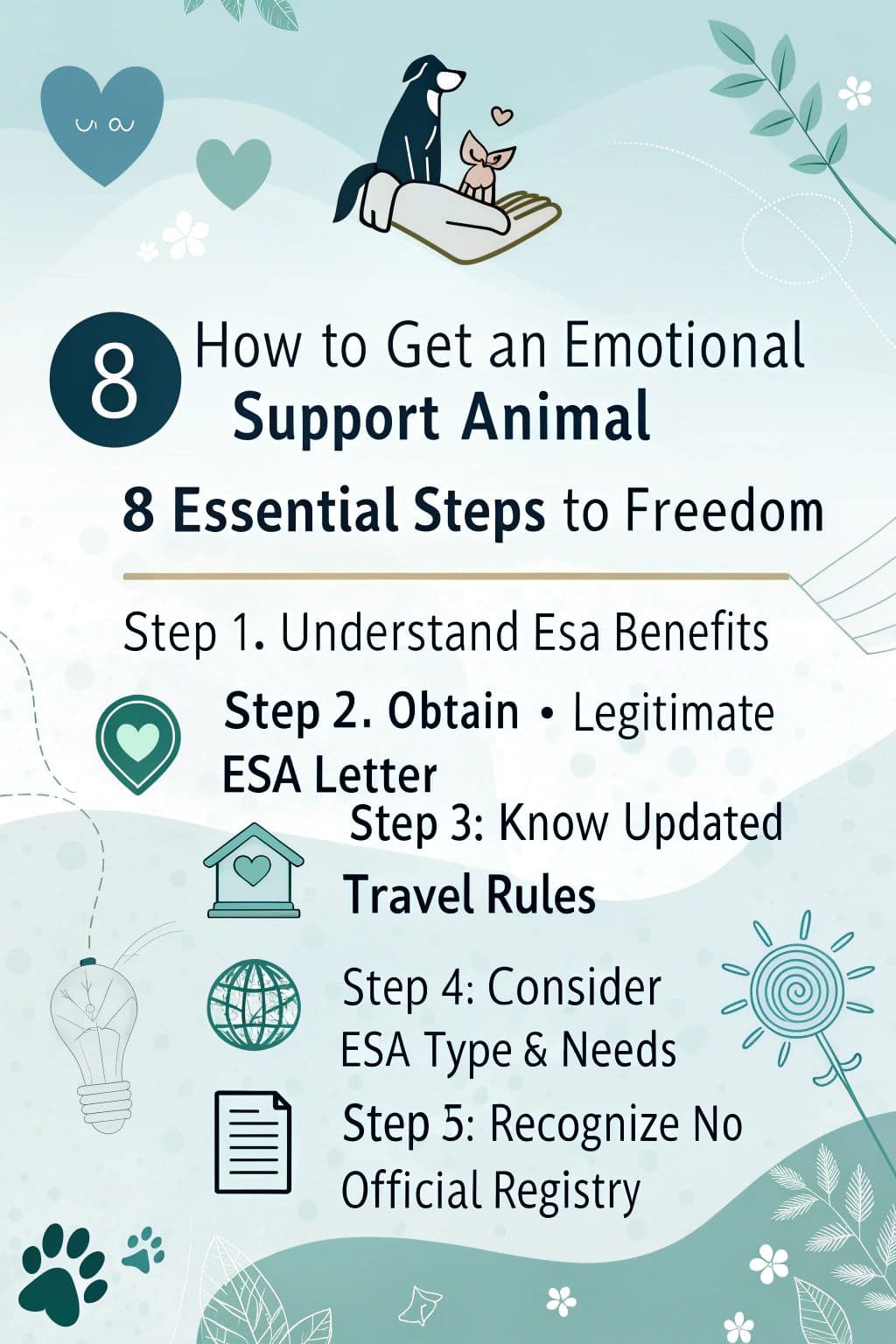Feeling down? Need a furry friend to lift your spirits? You’re not alone. Millions of people struggle with mental health issues every day. An emotional support animal might be just what you need.
This guide will show you how to get an emotional support animal in 8 easy steps. Ready to find your perfect companion?
Key Takeaways
Emotional support animals (ESAs) help people with mental health issues by providing comfort and lowering stress. They differ from service animals and therapy animals in training and legal rights.
To get an ESA, you need a letter from a licensed mental health professional stating your need for one. This letter is crucial for housing rights under the Fair Housing Act.
ESA air travel rules changed in 2021. Airlines no longer have to let ESAs fly for free, but service animals still can.
When choosing an ESA, consider factors like the animal’s temperament, size, energy level, and care needs. Dogs and cats are common, but other animals can be ESAs too.
There’s no official ESA registry. The only real “registration” needed is a legitimate ESA letter from a licensed mental health professional.
Table of Contents
What Are Emotional Support Animals (ESAs)?
Emotional Support Animals (ESAs) are more than just pets. They’re furry friends with a special job – to help folks deal with tough emotions and mental health stuff.
Definition and Roles of ESAs

Emotional Support Animals (ESAs) are more than just pets. They’re furry friends with a special job. These animals help folks dealing with mental health issues. They offer comfort and stability when life gets tough.
ESAs can be dogs, cats, or even rabbits. Their main role? To be there for their human pals.
ESAs work their magic by lowering stress levels. They can help bring down blood pressure and heart rate too. According to Wellness Wag ESA service, these animals play a big part in boosting overall mental health.

But here’s the catch – don’t try to pass off your regular pet as an ESA. That’s not cool and can get you in hot water. ESAs are for people who really need them. They’re a lifeline for those battling depression, anxiety, or PTSD.
Comparing ESAs, Service Animals, and Therapy Animals

Let’s look at the differences between ESAs, service animals, and therapy animals. Each has its own role and legal status.
| Aspect | Emotional Support Animals (ESAs) | Service Animals | Therapy Animals |
|---|---|---|---|
| Purpose | Provide comfort to owner | Perform specific tasks for disabled owner | Offer comfort to others |
| Training | No specific training required | Extensive task-specific training | Basic obedience and temperament training |
| Legal Status | Limited protections (housing, some air travel) | Full ADA protections | No special legal status |
| Public Access | Limited (where pets are allowed) | Allowed in most public spaces | Only where invited |
| Certification | ESA letter from mental health professional | No official certification required | May have therapy animal certification |
I’ve seen these distinctions confuse people. My buddy Jake thought his ESA pup could go anywhere… boy, was he in for a surprise at the local diner! ESAs are great for emotional support, but they don’t have the same access rights as service dogs. It’s important to know the difference to avoid awkward situations.
ESA Owner Rights
ESA owners have some sweet perks – but they gotta know their stuff. You’ll wanna brush up on your rights for housing and travel… it’s like having a secret superpower.
Housing Accommodations Under the Fair Housing Act

The Fair Housing Act is a game-changer for guys with emotional support animals. It’s got your back, fellas. Landlords must make reasonable changes to let you and your furry friend live together.
No more pet fees or “no pets” rules for ESAs. It’s a sweet deal.
But here’s the kicker – if a landlord says no to your ESA, you’ve got options. You can file a complaint with HUD. It’s like calling foul on unfair play. And get this… those pesky breed and weight limits? They don’t apply to ESAs under this act.
So your big, lovable mutt is welcome too. It’s all about giving you the freedom to live with your four-legged support system.
Air Travel with ESAs and the Air Carrier Access Act

While housing rights for ESAs are clear, air travel rules have changed. Flying with your furry friend used to be a breeze, but not anymore. In 2021, airlines got stricter. Now, they don’t have to let ESAs fly for free.
But don’t worry – service animals still get a free pass.
Planning ahead is key if you want to bring your ESA on a plane. You’ll need to submit papers at least 48 hours before takeoff. And here’s the kicker – you can only bring one ESA per flight.
So if you’ve got multiple support animals, you’ll have to choose your travel buddy wisely.
Preparation is the key to stress-free travel with your emotional support animal, says John Smith, a frequent flyer and ESA owner.
State Regulations on Emotional Support Animals
 State laws on emotional support animals (ESAs) can be tricky. Each state has its own rules. California and Florida have stepped up their game. They’ve made new laws to protect ESAs and fight fake services.
State laws on emotional support animals (ESAs) can be tricky. Each state has its own rules. California and Florida have stepped up their game. They’ve made new laws to protect ESAs and fight fake services.
These laws help real ESA owners and stop scammers. In some states, you need to see a therapist for a month before getting an ESA letter. This rule applies in California and Montana.
It makes sure people really need an ESA.
ESA laws can change fast. It’s smart to check your state’s current rules. Some states are stricter than others. They might ask for more proof or have special forms. Others are more relaxed.
But all states must follow federal laws like the Fair Housing Act. This act lets ESA owners live with their animals in most housing. Next, let’s look at how to qualify for an emotional support animal.
How to Qualify for an Emotional Support Animal

Qualifying for an emotional support animal isn’t as tough as you might think. It’s all about your mental health needs and getting the right paperwork from a pro.
Mental Health Conditions Eligible for an ESA
Guys, let’s chat about mental health and emotional support animals (ESAs). These furry pals can really make a difference for many conditions. Depression, anxiety, PTSD, ADHD, and bipolar disorder are at the top of the list of qualifying issues.
But here’s the thing – you need a professional to back you up. A mental health expert has to confirm that an ESA would help you cope. They’ll check your symptoms and decide if a companion animal is right for you.
An ESA can be a man’s best friend in the fight against mental health challenges.
It’s not just about feeling down or stressed. We’re talking about real, diagnosable conditions that interfere with your daily life. If you’ve been dealing with emotional abuse or other difficult situations, an ESA might help you feel better.
There’s no shame in getting help. It’s actually pretty courageous to admit you need support – even if it comes with four legs and a wagging tail.
Involvement of Licensed Mental Health Professionals
After figuring out if you’re eligible for an ESA, it’s time to talk to a pro. Licensed mental health professionals are crucial in getting an ESA letter. These experts include therapists, psychologists, and psychiatrists.
They’re the ones who can determine if you need an emotional support animal.
Getting an ESA letter isn’t just a quick chat. Your mental health pro will check your overall health. They’ll ask about your symptoms and how an ESA might help. It’s important to be honest – this helps them write a solid letter.
The letter must be on their official letterhead. It should also list their license info. This proves it’s legit and meets Fair Housing Act rules. If you can’t find a local pro, don’t worry.
Some offer online sessions, making it easier to get help.
How to Obtain an ESA Letter
Getting an ESA letter isn’t rocket science. You’ll need to chat with a mental health pro and explain why you need a furry (or feathery) friend to help you out.
Steps to Get a Legitimate ESA Letter
Getting a legit ESA letter doesn’t have to be a headache. Here’s how you can snag one without breaking a sweat:
- Find a licensed online provider: Look for reputable websites that offer ESA letter services. Make sure they work with real mental health pros.
- Schedule a live evaluation: Book a chat with a licensed mental health professional. This isn’t just a formality – it’s your chance to discuss your needs.
- Be honest during your assessment: Open up about your mental health. The more truthful you are, the better they can help you.
- Get your diagnosis: If you qualify, the pro will give you a mental health diagnosis. This is a key part of your ESA letter.
- Receive your ESA letter: After your eval, you’ll get your letter. It should include your diagnosis and the pro’s signature.
- Check the letter details: Make sure it’s on official letterhead and has all the needed info. This includes the pro’s license number and contact details.
- Verify the letter’s authenticity: Double-check that the mental health pro is legit. You can look up their license online.
- Keep your letter safe: Store it in a secure place. You’ll need it for housing and travel situations.
Essential Elements of an ESA Letter
An ESA letter is your golden ticket to freedom with your furry friend. It’s not just a piece of paper – it’s your key to unlocking doors. A legit letter must have three crucial parts: your mental health pro’s license number, your name, and why you need an ESA.
It’s like a recipe – miss one ingredient, and the whole thing falls flat.
A valid ESA letter is more than just words on paper; it’s a lifeline to emotional well-being.
But here’s the kicker – these letters aren’t forever. You gotta renew them every year, like updating your phone’s software. And don’t get fooled by fakes! Always check if your mental health pro is licensed.
It’s like making sure your mechanic isn’t just some guy with a wrench. Stay sharp, and you’ll be cruising with your ESA in no time.
Verifying the Authenticity of an ESA Letter
Spotting a real ESA letter isn’t rocket science, but it does take a keen eye. First off, check if a licensed mental health pro signed it. No fancy “ESA registry” stamp counts – those are often just smoke and mirrors.
A legit letter won’t promise the moon and stars overnight. If someone’s offering instant ESAs without a chat, run for the hills!
I once fell for a fake letter… big mistake. Learn from my goof-up: real ESA docs come from actual shrinks or therapists. They’ll include the pro’s license number and contact info.
Don’t be shy to ring ’em up and double-check. It’s your ticket to freedom with your furry friend, so make sure it’s the real deal. Trust me, it’s worth the extra effort to avoid headaches down the road.
Selecting the Appropriate Emotional Support Animal

Picking the right emotional support animal is key. It’s not just about cuteness! You need to think about your lifestyle, living space, and the animal’s needs too. Want to know more about finding your perfect furry (or scaly) friend? Keep reading!
Suitable Animal Types for ESAs
Dogs and cats are popular choices for emotional support animals. They’re easy to train and bond with. But other pets can be great too! Rabbits, guinea pigs, and even miniature horses make wonderful ESAs.
The important thing is finding an animal that suits your lifestyle and needs.
Your ESA should be calm and well-behaved in public. It also needs to handle stress well. Size is a factor – consider your living space and how much room you have. Any pet can be an ESA if it helps your mental health.
Let’s explore how to choose the perfect ESA for you.
Criteria for Choosing an ESA
Now that we’ve covered suitable animal types, let’s dig into picking the perfect ESA for you. Choosing your emotional support buddy isn’t just about cute faces or wagging tails. Here’s what to keep in mind:
- Temperament: Your ESA should be calm and easy-going. A jumpy or aggressive animal won’t cut it, especially in tight spaces like apartments or planes.
- Size: Think about your living situation. A Great Dane might not be the best fit for a tiny studio apartment.
- Energy level: Match the animal’s energy to yours. If you’re a couch potato, an energetic Border Collie might drive you nuts.
- Allergies: Don’t pick an animal you’re allergic to. That’s a recipe for disaster, not support.
- Care needs: Consider how much time and money you can spend on your ESA. Some animals need more attention and vet visits than others.
- Bonding potential: Choose an animal you connect with. That bond is crucial for emotional support.
- Training ability: While ESAs don’t need special training, a trainable animal is easier to manage in various settings.
- Lifespan: Think long-term. Are you ready for a 15-year commitment with a dog, or would a shorter-lived animal suit you better?
- Noise level: If you live in an apartment, a noisy parrot might not be the best choice. Consider your neighbors.
- Travel friendliness: If you plan to travel with your ESA, pick an animal that’s easy to transport and won’t freak out on a plane.
Living with an Emotional Support Animal

Living with an Emotional Support Animal can be a game-changer. It’s not just about having a furry friend – it’s about creating a safe space where you can thrive. Wanna know more about how these amazing animals can transform your life? Keep reading!
ESA Housing Rights Under the Fair Housing Act
The Fair Housing Act has your back if you’ve got an emotional support animal (ESA). It’s illegal for landlords to say no to tenants with disabilities, including those who need ESAs.
Even if a lease says, “no pets,” landlords must make exceptions for these helpful companions. It’s all about giving folks with mental health challenges a fair shot at housing.
But what if a landlord turns down your request? Don’t sweat it. You can file a complaint with the Department of Housing and Urban Development (HUD). They’re the watchdogs making sure everyone plays by the rules.
I once had a buddy who faced this exact situation. He stood his ground, filed a complaint, and guess what? He got to keep his furry friend in his apartment. It just goes to show – knowing your rights can make all the difference.
Introducing an ESA to a New Environment
Moving with your emotional support animal? No sweat! Talk to your new landlord first. Let them know about your furry friend. Show them your ESA letter from your doc. It’s your ticket to pet-friendly living.
Be open and honest – it’ll make things smoother.
Once you’re in, help your ESA adjust. Give them a cozy spot with familiar toys and blankets. Keep their routine as normal as possible. Walks, meals, playtime – stick to the schedule.
Your calm vibes will rub off on them. Soon, you’ll both feel right at home in your new digs.
Common Questions About ESAs

Got questions about ESAs? We’ve got answers! From flying with your furry friend to having more than one support animal, we’ll clear up the confusion… and maybe even make you chuckle along the way.
Keep reading to become an ESA expert!
Possibility of Multiple ESAs
You can have more than one emotional support animal. Some people need additional assistance, and that’s fine. Pettable, for instance, allows you to get a letter for two pets at no extra cost – which is great! Just keep in mind that each animal should play a role in your mental health care plan.
Having multiple ESAs isn’t about accumulating pets. It’s about receiving the support you need. Maybe a dog helps ease anxiety during daytime hours, while a cat provides comfort at night.
Or different animals might assist with various aspects of your mental health. The important thing is collaborating with your mental health professional to determine what works best for you.
ESA Policies on Flights
Flying with an emotional support animal isn’t as easy as it used to be. Since January 11, 2021, U.S. airlines have stopped recognizing ESAs. Now, only psychiatric service dogs can ride in the cabin without fees.
This change has left many ESA owners in a tough spot. But don’t worry – there are still options for air travel with your furry friend.
If you need to bring your ESA on a flight, plan ahead. Airlines require documentation at least 48 hours before takeoff. And here’s a key point: you can only bring one ESA per flight.
So if you have multiple support animals, you’ll need to choose just one travel buddy. Next up, let’s talk about how to pick the right emotional support animal for your needs.
Requirements for ESA Registration
Now that we’ve covered ESA policies on flights, let’s talk about registration. Here’s the deal: there’s no official ESA registry. Yep, you heard that right. Those websites claiming to register your emotional support animal? They’re often just scams.
Don’t waste your money. The only real “registration” you need is a legit ESA letter from a licensed mental health pro. That’s your golden ticket.
Some states have extra rules, though. They might ask for a 30-day relationship between you and your therapist before they’ll give you an ESA letter. It’s not about red tape – it’s to make sure you’re getting the right support.
So, if you’re thinking about getting an ESA, start chatting with a mental health expert now. They’ll help you figure out if an emotional support animal is the right fit for your needs.
People Also Ask
What’s an emotional support animal?
An emotional support animal is a furry friend that helps folks with mental health issues. These critters, often dogs, provide comfort to people dealing with anxiety, depression, or PTSD. Unlike service dogs, they don’t need special training. They’re just there to be your buddy and help you feel better.
How do I know if I need an ESA?
If you’re struggling with mental health problems like anxiety or depression, an ESA might be your ticket to feeling better. Chat with a mental health pro – they’ll help you figure out if a fuzzy companion could boost your mood. Remember, it’s not about being broken; it’s about finding what works for you.
What’s the deal with ESA letters?
An ESA letter is your golden ticket. It’s a note from a licensed mental health expert saying you need an emotional support animal. This letter can help you keep your pet in housing that usually says “no pets allowed.” It’s like a VIP pass for your furry friend!
Can I take my ESA anywhere?
Hold your horses! ESAs don’t have the same rights as service animals under the Americans with Disabilities Act. You can’t take them everywhere, but they do get some perks. They can live with you even in no-pet housing, and some airlines let them fly with you. Just don’t expect to bring them to restaurants or shops.
Do I need to get my ESA certified?
Here’s the scoop: there’s no official certification for ESAs. Anyone trying to sell you an “ESA certification” is pulling your leg. What you need is that ESA letter from a licensed mental health pro. That’s your real ticket to the emotional support animal world.
How do I pick the right ESA for me?
Choosing an ESA is like finding a new best friend. Think about what kind of animal makes you feel good. Dogs are popular, but cats, rabbits, or even birds can be great ESAs too. Consider your lifestyle, living space, and what kind of care you can provide. The goal is to find a furry (or feathered) pal that helps you feel calm and happy.
References
https://canyoncreekbh.com/blog/what-to-know-about-emotional-support-animals-esas/
https://www.umassmed.edu/TransitionsACR/resources/emotional-support-animals-101/
https://www.onehealth.org/blog/learning-the-difference-between-an-emotional-support-vs-service-animal (2021-12-21)
https://www.hud.gov/program_offices/fair_housing_equal_opp/assistance_animals
https://scholarship.law.uc.edu/cgi/viewcontent.cgi?article=1377&context=uclr
https://pettable.com/blog/acaa-emotional-support-animal (2023-11-22)
https://adata.org/guide/service-animals-and-emotional-support-animals
https://pettable.com/blog/emotional-support-animal-laws-guide
https://www.servicedogcertifications.org/how-to-qualify-for-an-emotional-support-animal/
https://screening.mhanational.org/content/how-do-i-get-emotional-support-animal/
https://pettable.com/blog/esa-registration
https://pettable.com/blog/types-of-emotional-support-animals
https://www.in.gov/ihcda/files/Emotional_Support_Animal.pdf
https://esadoctors.com/airline-requirements-for-traveling-with-an-emotional-support-dog/ (2024-09-24)

